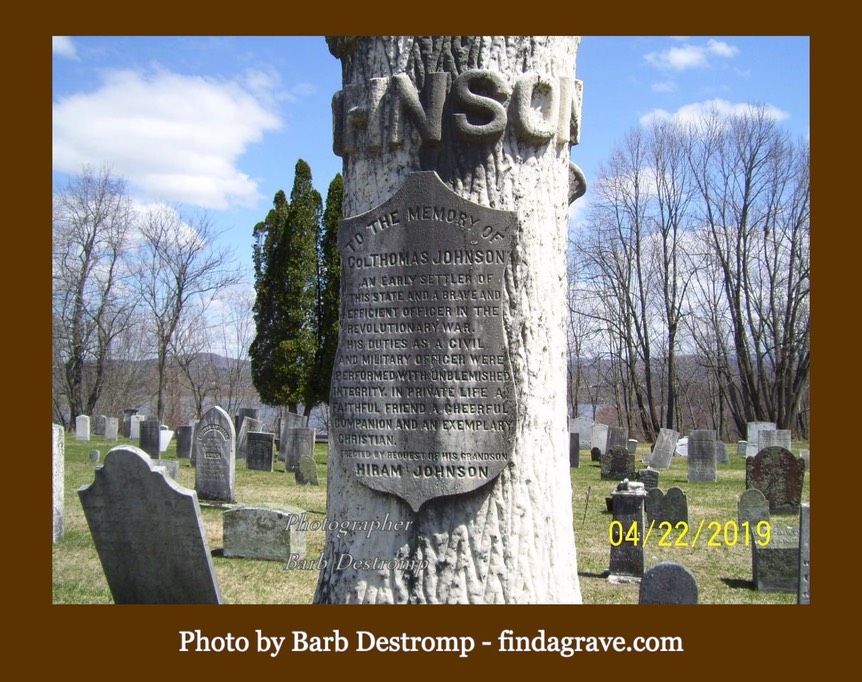When I listed the names Sylvester, Chamberlain, Taplin, and Bedel in my last post, On His Majesty’s Secret Service, I didn’t draw them out of a hat while blindfolded. Besides cropping up in a scholarly article about a British spy network operating in Vermont during the final years of the American Revolution, the four names have a long association with Lovewell history.
The first trace of a Lovewell in the New World is the record of John Lovewell marrying Elizabeth Sylvester at Scituate in 1659. John Chamberlain, according to ballad and oral tradition, killed the war-chief Paugus at the climax of Lovewell’s Fight in 1725. One of the men identified in the historical article as a tory spy, Col. John Taplin, was affiliated with Col. Nehemiah Lovewell in numerous ways. Besides being comrades-in-arms in the French and Indian War and the early years of the Revolution, five of Nehemiah Lovewell’s children married five from John Taplin’s household.
The name of the 19th Century “Science Guy” celebrated elsewhere on these pages, Joseph Taplin Lovewell, honors that proud interlacing of Lovewell and Taplin families, despite the fact that John Taplin high-tailed it to Canada as soon as Thomas Chamberlain began to blab to the Committee of Safety.
Col. Timothy Bedel was another veteran of both wars, though his record in the American Revolution might merit a closer inspection, given his secret proposal to muster a regiment, staff it with loyalist officers, and march to Canada where they would all promptly surrender. Soldiers under his command had surrendered unnecessarily once before, early in the war at the Battle of the Cedars, while Bedel was absent. In that earlier incident Timothy Bedel and his lieutenant were sent to court-martial by, ironically, General Benedict Arnold. Both were convicted.
Timothy Bedel’s son Moody Bedel was a drummer boy at start of the American Revolution, rising to the rank of brigadier general of volunteers by the War of 1812. Nehemiah Lovewell’s son Zaccheus, who also served in the Revolution, would name one of his sons Moody Bedel Lovewell. Moody Lovewell was, of course, progenitor of a generation of Lovewells who settled in the American West, most of whom can be found on this site.
After Cornwallis handed Washington his sword at Yorktown the citizens of Vermont were occasionally willing to overlook the nasty business churned up by the tories and turncoats in their neighborhood in 1782. History could even be rewritten to sidestep the issue. According to a chronicler of Montpelier, “on the opening of the Revolution, Colonel Taplin, declining to take sides against the king who had distinguished him, retired during the war into Canada, leaving his son, John Taplin, Jr., on the paternal property in Corinth, Vermont.” In a manner of speaking, that is what happened, sort of, omitting a few embarrassing details and shifting the timeline a wee bit.
On the other extreme there was the unfortunate case of Major White, one of Captain Pritchard’s spies who returned to Newbury four years later to dispose of some property. It was too soon. White was apprehended, publicly humiliated, then kept in jail before being driven out of town with whips and threatened with worse if he should ever return. Perhaps he hadn’t been that well-liked to begin with.
Levi Sylvester also eventually came home to Newbury but did so quietly, retiring to the wilderness outside of town with his Indian wife. When a female neighbor made the trek to the Sylvester cabin one day, Levi’s wife declared that she hadn’t seen another woman’s face for the past five years. Moving to Catharine, New York, decades later Levi applied for a pension and received one for his service early in the war.
Thomas Chamberlain managed to pick up where he had left off. He had been a justice of the peace before the Revolution. Upon his return home he was elected to the same post and reelected afterward.
According to J. Robert Maguire’s 1967 paper on the subject of the failed attempt to kidnap General Bayley, “Of all those involved in the plot, the most injured was Col. Thomas Johnson of Newbury, who in trying to serve both sides incurred the enmity of loyalists and patriots alike, from which he suffered a public obloquy which outlived his death thirty-seven years later.”
Only at the end of his paper does Maguire repeat a tale of post-mortem vengeance contained in Frederic P. Wells’ 1902 history.
“…many years ago the word ‘Tory’ was found scratched upon the stone in the Oxbow cemetery, which marked the grave of a certain revolutionary officer, whose situation during the war had made him the object of much annoying criticism from his enemies. The culprit was discovered, and a bitter feud resulted between two families which out lasted that generation.”

Colonel Thomas Johnson is buried in the Oxbow Cemetery, his grave overshadowed by a towering memorial.
(Also see "On His Majesty’s Secret Service” and “The Gang That Couldn’t Spy Straight)